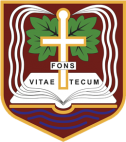With thanks to Isabelle Fautrero-Sayer
The beginnings
St Mary’s school was founded in 1749 by Dr Edwards Young, Rector of Welwyn Parish.
Originally housed in what is known as Tudor Cottage (next to the Church) and adjacent cottages (now demolished), it had been donated for the poor of the Parish’s use.
 Before he came along, tutoring was reserved for children of the wealthiest members of the community. Dr Young was incredibly generous: he paid for a new school house to be built on the Ancor Pightle (behind the Rose and Crown pub), provided clothes for the 16 boys who attended it, managed it himself until his death in 1765 and even left some of his own money into a charitable trust to ensure the school could continue after that. A school master, Mr Pentlow, was appointed while the board of trustees kept an eye on the school’s progress and its finances.
Before he came along, tutoring was reserved for children of the wealthiest members of the community. Dr Young was incredibly generous: he paid for a new school house to be built on the Ancor Pightle (behind the Rose and Crown pub), provided clothes for the 16 boys who attended it, managed it himself until his death in 1765 and even left some of his own money into a charitable trust to ensure the school could continue after that. A school master, Mr Pentlow, was appointed while the board of trustees kept an eye on the school’s progress and its finances.
At the time, the pupils were all boys between the age of 7 and 14. Girls didn’t start to be admitted until 1822. The school only taught reading, writing and arithmetic which, in those days, was deemed sufficient ‘to fit them for apprentices or other services’. They also learnt catechism and studied the Bible. Their school day ran from 7 a.m. (8 a.m. in winter) to 11 a.m. and 1 to 4 p.m. The boys had to keep a strict attendance, being expelled if they missed more than 3 days in one month (except in case of sickness and at harvest time). The same applied if they were ‘guilty of swearing or any other disorderly behaviour’ in and out of school. They were also expected to keep ‘neat and clean from vermin’. At the start of every year, they were provided with a set of leather breeches, flannel waistcoat, yarn stocking and boots but no uniform was yet in place.
New developments
In the 1830s, a new schoolroom was erected to house 100 boys in School Lane (still known as New Place Lodge) but was later sold and during 1857/8, a new national school opened on London Road (in front of the present school) which accommodated 96 boys, 70 girls and 60 infants and a new school master.
 Only minor parts of these buildings are still in existence (between our current school building and the Steamer Pub) having now been converted into private accommodation for the elderly.
Only minor parts of these buildings are still in existence (between our current school building and the Steamer Pub) having now been converted into private accommodation for the elderly.
The staff then consisted of only a school master, two women in charge of the girls and infants and two pupil-teachers. As for the school funding, it had started to be supplemented by a government grant, local subscriptions and the weekly payment of the ‘School Pence’ (the poor paid less than children of tradesmen & farmers). Welwyn School eventually received greater funding in 1870, when a government act aimed to give every child access to primary and elementary education; the right to vote necessitated indeed an understanding of current issues and the industrial revolution meant an educated population was required to understand written instructions, accounts and be able to produce reports.
By 1887, the Infants schoolroom had to be extended as more children came to school and a new hall erected. St Mary’s Rector also set up the first evening classes. Better known as ‘night schools’, they offered men and boys over 14 some basic skills in reading, writing, arithmetic, geography and technical knowledge in drawing and carpentry. Once schooling was so widely available, absenteeism started to become a major problem though. Government grants could indeed be withdrawn if pupils didn’t attend enough school sessions nor met prescribed standards. Discipline was strict and talking in class was punished by the cane as was most minor misdemeanour.
Up to the 1940s and 1950s, poor health was also an issue. Before antibiotics and immunisations, outbreaks of contagious diseases such as diphtheria, scarlet fever, measles or simply influenza necessitated frequent school closures. The First World War impeded developments and in 1926, part of the school was destroyed by fire. It was improved and enlarged during the rebuilding to include a science, woodwork, cookery and laundry room.
The First World War impeded developments and in 1926, part of the school was destroyed by fire. It was improved and enlarged during the rebuilding to include a science, woodwork, cookery and laundry room.
St Mary’s was one of the first schools in the country to provide school dinners because so many children now came from the surrounding areas (a child paid 4d per day).Unlike many inner city schools, the Second World War had a relatively limited effect on the school. Assembly had to start later at 9.30 to give pupils some well needed rest after many night air raids and the school closed earlier in winter; trenches were dug to take cover but these got too wet for good use.
Post war changes
 Despite the start of WWII, the current building was opened in 1940 as a secondary-modern school. It had been built on an adjacent ten acre site to house the over-11s at a cost of £31,500.
Despite the start of WWII, the current building was opened in 1940 as a secondary-modern school. It had been built on an adjacent ten acre site to house the over-11s at a cost of £31,500.
A daily diary of the building work was kept by the senior pupils which, together with the original plans, is still in existence nowadays. St Mary’s was the only Church of England secondary school in the district and aimed to consolidate local teaching resources for over-11s under one roof.
The school also tried to meet rural needs and stimulate horticultural practice as ‘a science and an art with intelligent hands’ by putting rural science and gardening on the curriculum. Once the necessary wartime production of potatoes and cabbage on site was no longer needed, the vegetable patches were turned into lawns and borders; shrubberies and specimen trees were also planted. A full time grounds man was appointed in 1942 and soon helped grow and propagate nine  different types of fruit such as rhubarb, raspberries and blackcurrants.
different types of fruit such as rhubarb, raspberries and blackcurrants.
With the county’ financial assistance, a yew hedge was planted to flank the entrance drive (then completely straight) used by the buses to drop off children from the surrounding villages. The school also boasted an impressive 4 acre garden under intense cultivation with an apple, pear and plum tree orchard (where the nature reserve now is).
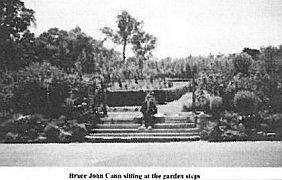 Under the management of a new head teacher, Mr Savage, the school opted for a Voluntary Aided status in 1944 to maintain its strong link with the church, which meant it had to bear 50% of the cost of updating the buildings to required standards.
Under the management of a new head teacher, Mr Savage, the school opted for a Voluntary Aided status in 1944 to maintain its strong link with the church, which meant it had to bear 50% of the cost of updating the buildings to required standards.
A 50ft x 8ft greenhouse was added in 1950. Although the latter is long gone, the subsequent garden laboratory of 1956 remains… now housing Welwyn Under Five but having also been used by a small behavioural support unit for 11 to 16 year olds for a long time. A cycle shed stood where our new one is today and in 1952, tennis courts were built where the current Junior (KS2) field is. 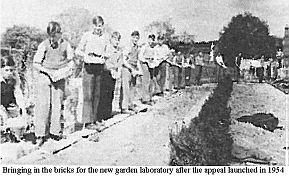 As a precursor to our PTFA, private subscription played a big part in the developments carried out in St Mary’s school, alongside the Diocese funding. Throughout the fifties and sixties, school shows were even staged by pupils and staff to raise funds!
As a precursor to our PTFA, private subscription played a big part in the developments carried out in St Mary’s school, alongside the Diocese funding. Throughout the fifties and sixties, school shows were even staged by pupils and staff to raise funds!
In 1954 and1958, more classrooms were added to the original primary school Victorian buildings and in the 1960s, further extensions were built into the newer secondary school to house a science lab, a library and a dining hall (still in existence) which helped define our well known ‘quad’.
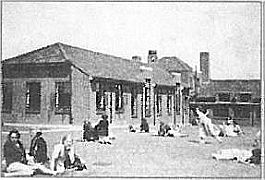 The 60s revolution
The 60s revolution
Education in Hertfordshire was however changing and it was felt that selection at 11 years of age was unfair. St Mary’s, together with two other local secondary schools and two Welwyn Garden City grammar schools were amalgamated into four comprehensives. Amid furious opposition, St Mary’s Secondary Modern was closed in 1968/69, and over-11s were merged into one of them: the new Monk’s Walk Comprehensive School. 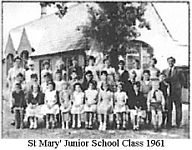 The newer St Mary’s building became the junior school, leaving the infants in the Victorian building. At that time, there were 223 juniors and 139 infants under the supervision of head teachers Mr Trevena and Mrs Madden, respectively.
The newer St Mary’s building became the junior school, leaving the infants in the Victorian building. At that time, there were 223 juniors and 139 infants under the supervision of head teachers Mr Trevena and Mrs Madden, respectively.
The pre-war methods of streaming, drilling and seating children in rows of desks soon gave way to working in groups of small tables and chairs, self expression, discovery and learning through projects covering all subjects – English, maths, history, and geography. Music and drama were still prominent but the curriculum was enriched through the introduction of visiting specialists in French, needlework, music, dancing and so on, enlisting the help of parents in the classroom, the library and for out of school activities.
An indoor swimming pool was also opened in 1970, largely financed by private subscription. Some parents even helped with the actual building work! Up to then, swimming lessons had taken place at the Clock (formerly a hotel).
Children had some form of physical activity every day, such as football, netball, gymnastics, music and movement, swimming, etc.
In 1971, Kit Trevena led a party of 27 pupils and 3 teachers for a week stay in Champagne-sur-Oise, France, forging strong links between the school and the town. The Welwyn Anglo-French Twinning Association was born from there.
The 70s reunion of infants and juniors
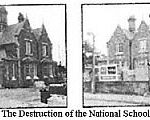 In the late 1970s, as the post-war ‘baby-boom’ tailed off and the new Oaklands Primary School opened, both buildings had spare capacity. The Infants old building also had its limitations so it was decided to merge the infants and juniors into the larger, more modern building.
In the late 1970s, as the post-war ‘baby-boom’ tailed off and the new Oaklands Primary School opened, both buildings had spare capacity. The Infants old building also had its limitations so it was decided to merge the infants and juniors into the larger, more modern building.
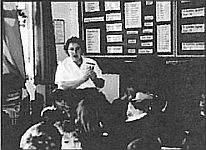 The last day that St Mary’s occupied the Victorian building was 15th Feb 1985 when it was sold and demolished to make way to accommodation for the elderly. Mrs Ann Stevens was appointed head of infants when they merged and only recently retired. Mr Michael Jones, who had succeeded to Mr Trevena as head teacher in 1977, oversaw the move and subsequent alterations of the new ‘combined’ primary school to accommodate the infants (e.g. the addition of the Year 2 classroom overlooking the KS1 playground, closing of the pool), which the old building sale had funded.
The last day that St Mary’s occupied the Victorian building was 15th Feb 1985 when it was sold and demolished to make way to accommodation for the elderly. Mrs Ann Stevens was appointed head of infants when they merged and only recently retired. Mr Michael Jones, who had succeeded to Mr Trevena as head teacher in 1977, oversaw the move and subsequent alterations of the new ‘combined’ primary school to accommodate the infants (e.g. the addition of the Year 2 classroom overlooking the KS1 playground, closing of the pool), which the old building sale had funded.
The 80s/90s
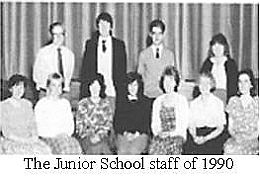 Mr John Oates steered the school’s desperate needs for refurbishment through times of financial stringency, the introduction of the National Curriculum and league tables in 1988 and the change to locally controlled school budgets in 1991. His arrival coincided with a huge proportion of staff retiring. Morale was soon restored thanks to the energy and enthusiasm of new staff and the successes of the school sports teams. Mr Oates is also remembered for boosting drama and music with his assembly puppet shows and, with the first production of The Incredible Vanishing in 1991, a play by a new amateur dramatic group consisting of school PTA members, staff and pupils. St Mary’s Amateur Repertory Theatre (better known as SMART) was born! 1987 was the year the nature reserve was created by parents & teachers in the school grounds (only to be rejuvenated by more parents and staff in 2009!)
Mr John Oates steered the school’s desperate needs for refurbishment through times of financial stringency, the introduction of the National Curriculum and league tables in 1988 and the change to locally controlled school budgets in 1991. His arrival coincided with a huge proportion of staff retiring. Morale was soon restored thanks to the energy and enthusiasm of new staff and the successes of the school sports teams. Mr Oates is also remembered for boosting drama and music with his assembly puppet shows and, with the first production of The Incredible Vanishing in 1991, a play by a new amateur dramatic group consisting of school PTA members, staff and pupils. St Mary’s Amateur Repertory Theatre (better known as SMART) was born! 1987 was the year the nature reserve was created by parents & teachers in the school grounds (only to be rejuvenated by more parents and staff in 2009!)
The improvements of the millennium
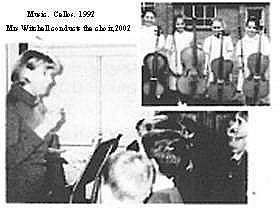 Mrs Witchell took over in 1996 just in time for the first OFSTED report which she succeeded in turning from ‘good’ to ‘very good with outstanding features’ in 4 years.
Mrs Witchell took over in 1996 just in time for the first OFSTED report which she succeeded in turning from ‘good’ to ‘very good with outstanding features’ in 4 years.
She made her mark in raising the musical standards of the school, even leading the choir and singing in Assembly herself.
Throughout the ‘noughties’, the school benefited from a very active Parent Teacher – and now Friends – Association (became PTFA in 1996) with a series of fundraising events that followed on from an all-time successful auction of promises in 2001 (starring the singer and garden designer Kim Wilde). Family bingos succeeded craft fairs, balls and a jubilee picnic. This made a renovation of both junior and infant playgrounds possible and, with the constant help of the SMART productions, the hall curtains were eventually replaced.
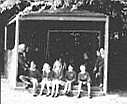
 The PTFA went from strength to strength, contributing to a new IT room with the latest computers and software in 2002 and brand new play equipment being erected on soft rubberised surfaces in the Infant playground in 2006. In 2008, astroturf was also laid down to enhance the shady part of the KS1 (Infant) playground. By 2009, all classrooms had been fitted with electronic white boards and visualisers. The school had definitely moved into the 21st century!
The PTFA went from strength to strength, contributing to a new IT room with the latest computers and software in 2002 and brand new play equipment being erected on soft rubberised surfaces in the Infant playground in 2006. In 2008, astroturf was also laid down to enhance the shady part of the KS1 (Infant) playground. By 2009, all classrooms had been fitted with electronic white boards and visualisers. The school had definitely moved into the 21st century!
2005 also saw the emergence of a new body, the School Fund. Operating alongside – but independently from – the PTFA, it was created to provide an alternative way of contributing to the school for parents who did not have the time to get involved with the PTFA activities. The School Fund purchases educational resources beyond the scope of the normal school budget such as 7 new classroom PCs in 2010.
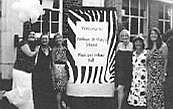
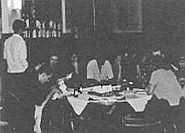 Thanks to a succession of large-scale PTFA-led fundraising events such as 5 years of summer evening parties with silent auction, annual Christmas fairs run with military precision, indulgent ladies pampering evenings, fashion shows, quizzes, mothers and fathers’ day gift shops, recycling schemes, sponsored bounces, plant and cake sales, the money raised by the PTFA peaked at £20,000 per annum towards the end of the decade.
Thanks to a succession of large-scale PTFA-led fundraising events such as 5 years of summer evening parties with silent auction, annual Christmas fairs run with military precision, indulgent ladies pampering evenings, fashion shows, quizzes, mothers and fathers’ day gift shops, recycling schemes, sponsored bounces, plant and cake sales, the money raised by the PTFA peaked at £20,000 per annum towards the end of the decade.
An Olympic future
Mrs Westley, Welwyn St Mary’s Primary School’s former head teacher joined in 2009 when Mrs Witchell retired. Since then, the school has continued to improve its facilities, helped with the financial and hands-on contribution of dedicated governors, a very active PTFA and committed parents. The more successful fundraising events are still running with new additions (magic shows, race nights, photographic portrait sessions,…).
In 2010, the nature reserve was rejuvenated and a new outdoor classroom built. The school libraries have been updated with new books and an array of maths resources have been purchased. The computers in the school ICT suite are continually upgraded to keep up with technological advances. 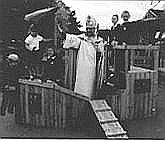 In 2011, the opening of a new outdoor learning space for Reception children was blessed by the Bishop of Hertford. The car park was resurfaced and safer routes for pupils to move between playgrounds and collection points were redefined; a new storage area was built in the gym to house sports equipment; a toilet for the disabled and a new teacher preparation and planning room were added; a teacher even ran the London marathon to fund a new bike shelter and finally, the school was redecorated and gardens tidied up with new beddings. With some help from the Diocese, a covered walkway was also built to link the lower and upper part of the school across the quad.
In 2011, the opening of a new outdoor learning space for Reception children was blessed by the Bishop of Hertford. The car park was resurfaced and safer routes for pupils to move between playgrounds and collection points were redefined; a new storage area was built in the gym to house sports equipment; a toilet for the disabled and a new teacher preparation and planning room were added; a teacher even ran the London marathon to fund a new bike shelter and finally, the school was redecorated and gardens tidied up with new beddings. With some help from the Diocese, a covered walkway was also built to link the lower and upper part of the school across the quad.
And that is not all! The PTFA has already started to allocate funds towards a staged facelift of the junior playground. The school has not stopped evolving to meet the demands of modern life and satisfy the requirement for self-fulfilment of its pupils but Dr Young’s motto still prevails: “The offspring of sound learning is Virtue”
